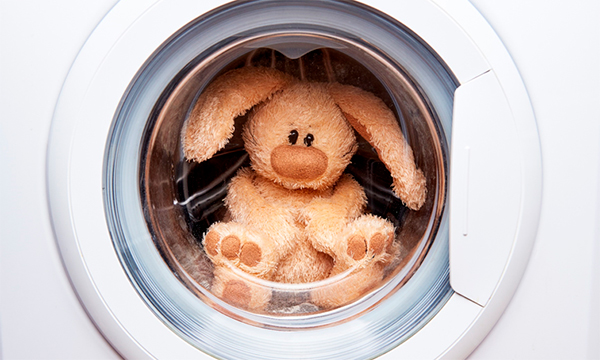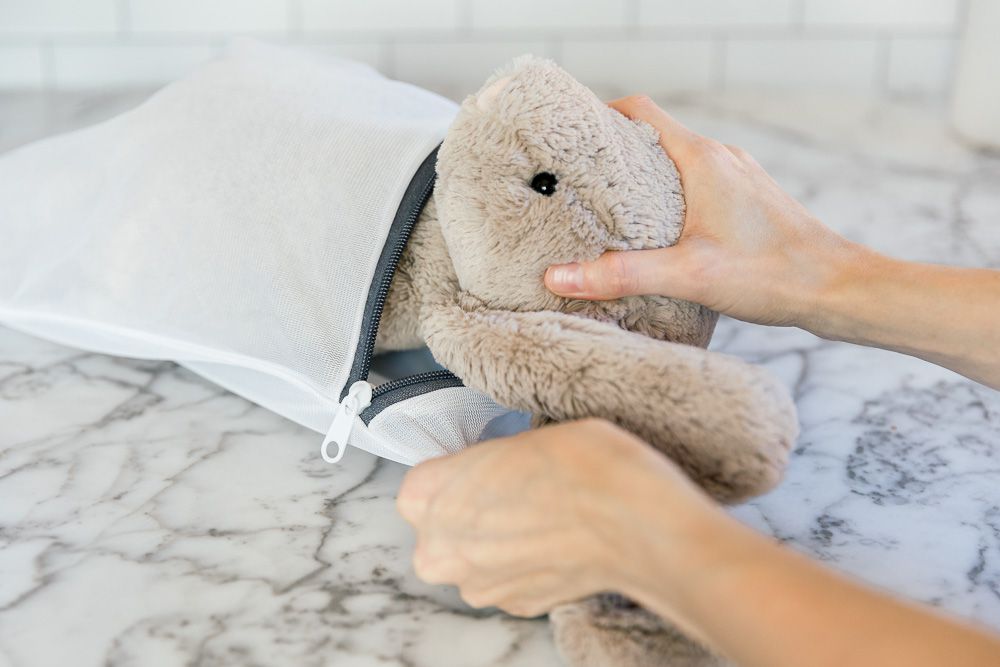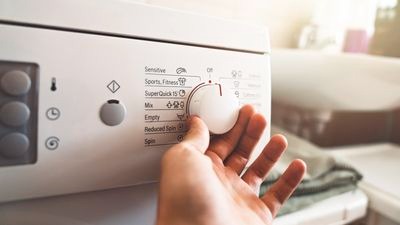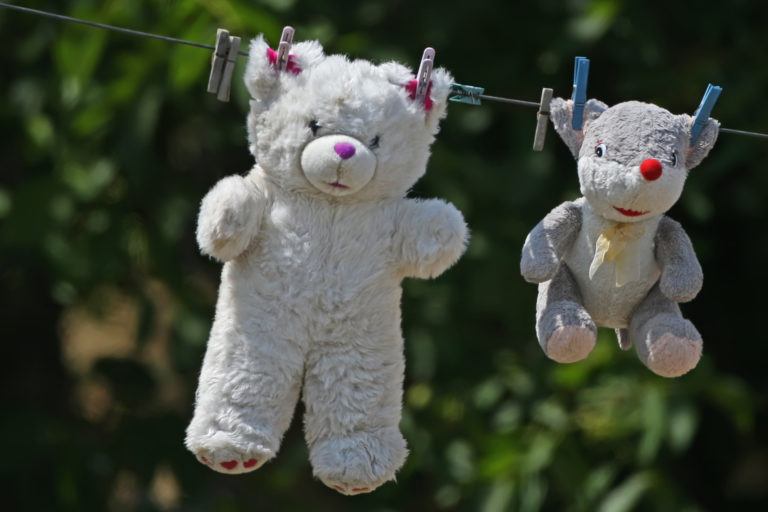Soft toys are beautiful, pleasant to the touch and are very popular with children of all ages. But parents are wary of them, because they know that these are real “dust collectors”. So that the health of the child is not endangered by daily contact with toys, which collect not only dust and dirt, food debris, but also microbes, other potentially dangerous microorganisms, they must be regularly washed or cleaned in some other way. How to do it correctly, the experts will tell in this article.

What toys can and cannot be washed in a washing machine or by hand
To determine if the toy can be washed, look at the information on the tag. There are always tags on more or less expensive products. But sometimes parents cut them off so as not to spoil the appearance of the toy. Therefore, if there is no label, you will have to figure it out yourself. Take a good look at the thing, feel it — if there are any pressure elements on it, behind which microcircuits can hide. If there is, such products cannot be washed at all. Also, you should not subject such products with organic fillers, for example, with peas, buckwheat husks, down / feathers, medicinal herbs, sawdust, small stones, sea salt, wool, etc. to wet processing.
There are toys that can be washed, but only by hand:
-
Those that have some details that are fixed on the glue. Short manual processing will not cause the adhesive to dissolve. But if the part still peels off, you will get it from the bottom of the basin and fix it again. And when washing in a washing machine, small parts, like buttons, can clog the water outlet hose or somehow damage the mechanism.
-
Too big — more than 15–20 cm in “height”. Even if a thing is quietly placed in the drum of a washing machine, when wet, it will turn into a heavy lump that will pound against the walls and can damage the washing machine and disable the mechanism. We wash such toys, but only by hand.
-
Handmade items that are unlikely to withstand intensive processing in the drum of a washing machine. But gentle hand washing won’t hurt them.
-
Antistress toys. Inside such products there are many small balls of expanded polystyrene, and their shell is very thin. If the material breaks during washing in the washing machine, it will be a disaster, as the balls will need to be collected all over the bathroom or kitchen. And with manual processing, you control the force of friction, so do not damage the thin fabric.
If the toy cannot be washed at all, it can be cleaned in other ways, which we will discuss later in the article.
How often should soft toys be washed?
There are no strict rules regarding this issue, but there are recommendations from pediatricians and other specialists:
-
If a child comes into contact with a toy every day, often takes it in his mouth, drops it on the floor, gets it dirty while eating, then you need to wash it as often as possible, even every day.
-
If the child plays with the product from time to time or very carefully, does not pull into his mouth, does not throw it on the floor, does not take it out into the street, washing can be carried out as it gets dirty or once every 10–14 days.
-
If the toy performs a purely decorative function, for example, it stands on a shelf, on the back of a crib, you need to clean it once every few months to simply remove dust and prevent the occurrence and reproduction of dust mites.
If a child has been ill with a disease that is transmitted by airborne droplets, food or contact, toys should be washed or cleaned immediately after recovery. It is optimal to boil, but modern toys are unlikely to survive such treatment. Therefore, you can first wash, and then disinfect under an ultraviolet lamp. You can also use a household steam generator for disinfection. And the easiest, and so to speak, “budget” way to at least partially disinfect the product is to take it out for 8–10 hours on a balcony or on the street for direct exposure to sunlight.
Preparing for washing

If you decide to rub children’s toys, prepare each of them for the procedure:
-
Inspect the toy, if it has open seams or parts that are about to come off, fix the product.
-
If things have electronics, but it is removable, remove, remove the batteries.
-
Remove as much dirt and dust as possible with a brush. The operation is best done outdoors, as an option — on the balcony.
-
If the product has stubborn stains that are unlikely to be washed off, treat them with a stain remover, following the manufacturer’s instructions. As an impromptu stain remover, you can use alcohol, soda diluted with water to a gruel state, vinegar or lemon juice.
-
If the product is made of delicate fabrics, lace, etc., it is better to wash it in a special mesh bag.
It is better to wash soft toys not one at a time, but several at once, so that they evenly fill the drum of the machine. At the same time, it is not necessary to hammer the drum “to the eyeballs”, otherwise things will not be washed well and rinsed out worse. You also need to sort products by color — whites are processed separately from colored and painted in very dark colors.
Detergent selection
The choice of powder is a very important stage, since the child will be in constant contact with the products, perhaps taking them in his mouth, pressing them against the delicate skin of his face. Firstly, the powder should not be loose, it is better that it be a liquid, gel product. It has a number of advantages:
-
Not as aggressive as dry powders.
-
It dissolves best in cold water.
-
It rinses out better.
-
Does not damage fabric fibers.
Secondly, it should ideally be hypoallergenic, environmentally friendly, made from natural ingredients, free of phosphates and other harmful substances. Immunity in children of the first years of life, and even in preschoolers, is still not strong enough, you should not use chemistry once again, if this can be avoided, so as not to further weaken the protective functions of the body.
As a safe and at the same time quite effective means for washing soft toys and other children’s (and adult) things, a liquid detergent made by hand from laundry soap and soda ash has proven itself to be excellent. It is done very simply and quickly enough:
-
Take 90 grams of laundry soap, grind in any way, the easiest — on a grater for vegetables.
-
Take 90 grams of soda ash, it is sold in hardware stores, where you can buy household chemicals. This is an absolutely safe substance, which differs from ordinary baking soda only in that it has undergone heat treatment, that is, calcination. Heating is needed in order to increase the cleaning properties of soda.
-
Place soap and baking soda in a pot with 3–4 liters of boiling water. Determine the amount of liquid, starting from how thin or thick the product should be in your opinion.
-
Mix thoroughly until the components are completely dissolved.
-
Turn off the gas, let the gel cool down, pour into the containers in which it will be stored. When the product has almost cooled down, you can add a few drops of essential oil to it, which does not cause allergies in a child, the smell of which the baby likes. But even without this component, things after washing will smell absolutely normal, especially if you dry them in the fresh air.
Such a liquid powder is used in the same dosages as purchased detergents, it can be measured with the same cap or with a measuring cup.
Temperature, mode, spin

Children’s soft toys are washed on a gentle cycle. It can be “delicate wash”, “hand wash”, “wool”, etc. Instead of using a specific program, you can set all the parameters manually:
-
The temperature is 40 degrees.
-
Spin — 400 revolutions.
-
The duration of washing is 1–1.5 hours.
-
Extra rinse — yes.
If the toy is made of materials that can withstand exposure to higher temperatures, such as cotton, linen (considering the stuffing material), be sure to use this and wash it in hot water. So you not only clean better, but also destroy more opportunistic microorganisms.
After washing, dry the toys on a line or on the dryer bars, preferably outdoors. If they need to be wrung out first, then proceed carefully, do not twist them, wrap them in a terry towel and press them with your hands so that the moisture is absorbed into the fabric.
How to wash soft toys by hand
Hand washing soft toys is no different from washing things. Except that if the toy is large, it will be very heavy when wet, it will be difficult to clean it from the detergent and wring it out, it will take a very long time to dry. Nevertheless, we describe the process:
-
Fill a suitable container with water at a temperature of 40 degrees, that is, it should be slightly hotter than your skin. There should be enough water so that after soaking into the toy the container is about half full.
-
Dissolve detergent in water. It is better to take a gel, since the dry powder will not dissolve well, get stuck in the fibers of the material, and become a potential allergen.
-
Immerse a toy or several products in water, lather well with a washcloth or sponge. Rub on all sides, if necessary — additionally use a brush of medium hardness. Leave the product to soak for 30 minutes.
-
Rub again on all sides, especially heavily soiled areas, wrinkle, “squeeze”. Squeeze out soapy water.
-
Rinse in clean water so many times that in the end the water becomes clear, without a hint of foam.
-
Squeeze out the water without twisting the product, wrap it in a towel and flatten it, hang it or put it on the dryer rails to dry completely.
Do not give your child a soft toy until it is completely dry. It will quickly become dirty, and unwanted microorganisms may begin to multiply inside the filler.
How to dry soft toys quickly

It is important to quickly dry the product not only because the child misses it. If this process is delayed, the stuffing inside may become moldy, and other representatives of microflora may develop in conditions of relative warmth and humidity. Here are a few ways to quickly dry your baby’s soft “friends”:
-
Hang on a rope or dryer bar outside, under warm sunlight (only if these are not knitted products, otherwise they can stretch, it is better to dry them in a horizontal position).
-
Dry things near the radiator (not on the heater), periodically turning them on different sides to the heat source.
-
In the cold season, you can dry soft toys on the windowsill, under which there is a battery or radiator. The heat will promote drying, and the sun’s rays from the window will not only dry, but also disinfect the fabric.
-
Use a hair dryer on medium heat setting.
You can also quickly dry the item in an electric dryer, but only if it is allowed by the manufacturer, as indicated on the tag.
If you can not wash soft toys, what to do
If for some reason it is impossible to wash a thing, it can be cleaned in other ways. The easiest (if there are no stains) is to vacuum it, you can additionally process it with a steam generator. There are also cleaning methods:
-
Place the product in a plastic bag, pour in a portion of baking soda (focus on the size of the item), tie the bag, shake well so that the soda is distributed over the entire surface of the product.
-
Leave the bag tied for 2 hours.
-
Spray a terry towel of a suitable size with water from a spray bottle or moisten it in any other way.
-
Wrap the toy in a towel, carefully wrinkle on all sides.
-
Remove baking soda residue with a soft-bristled brush.
This method of cleaning will get rid of dust and dirt, microorganisms. You can more effectively disinfect the product by freezing it. That is, while the toy is in the bag, you squeeze the air out of it and put it in the freezer for several days — most bacteria and microbes will die from exposure to low temperatures.
If the toy has microcircuits, speakers, batteries, it can be cleaned with soda, but not frozen. Another option is to carefully open the seams and remove the electronics, then sew the thing up so that the filler does not fall out, wash the product and restore the seams completely.
Conclusion
It is necessary to monitor the cleanliness of soft toys for children not only in order to increase their service life and maintain their aesthetic, attractive appearance. This is necessary for hygiene reasons, since a dirty thing is not only ugly, but also dangerous for the baby. The product becomes a source of dangerous microorganisms and dust mites, so dry cleaning or washing should be carried out regularly.

Добавить комментарий
Для отправки комментария вам необходимо авторизоваться.